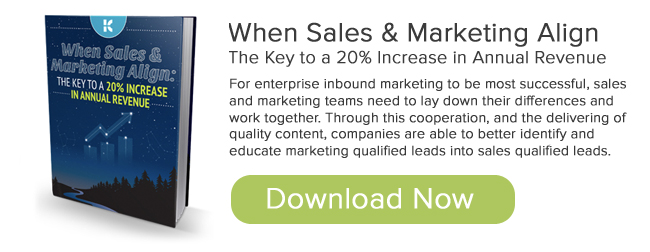Your leads are the driver of your business. To grow and to gain customers you need to have quality leads that are actively engaged in your organization’s offerings—leads that are a fit for organizations strategy.

While every organization has a unique approach to categorizing its leads, there are several myths associated with lead quality many organizations fall to. Lets take a look at 10 lead quality myths and debunk them using facts derived from industry data.
Myth 1: Any lead is a Good Lead
Fact: You might think, “Look at all these leads we are pulling in! We need to get our sales team to follow up with these leads ASAP and close some deals!” Well, you could do that, but you will find that most of those leads are not ready to buy—in the time they became a lead to the time it took your sales team to reach out to them they haven’t experienced enough touch points with your audience.
Unfortunately, about 61% of B2B marketers still send all leads they receive directly to sales while only 27% of those leads will actually be qualified for a sales call. Remember, you should not pursue every lead you receive. You need to establish a system that better identifies a “hot” lead from someone who is just poking around.
Myth 2: Defining a Process for Scoring Leads Is Not Essential to Produce High Quality Leads
Fact: Defining an in-depth lead scoring process might not be a viable option for all business. In many cases, these scoring systems can be complex, utilizing a lot of data and requiring an extensive CRM system to manage.
However, no matter the size of your company, your technology capabilities or your sales pipeline, it is essential to determine some way to determine which leads are “hot” and which are “cold. You do not need a complex CRM-driven system to develop scoring criteria, but you should have a process in place. In fact, companies that have set up lead scoring have seen an ROI of 138% versus companies without any lead scoring criteria.
Myth 3: Lead Nurturing Is Not Essential to Produce High Quality Leads
Fact: Lead nurturing is perhaps one of the best ways to produce high quality leads. Not everyone who visits your site and fills out a consultation form is going to be qualified. This is where lead nurturing comes in. In fact, 79% of marketing leads never convert into sales due to a lack of lead nurturing. Companies that establish a system for nurturing their leads on average produce a 20% increase in sales opportunities versus non-nurtured leads.
Myth 4: My Sales Team Is the Best Resource I Can Use to Gauge if a Lead Is a Good Fit
Fact: It’s true that your sales team can gain insight about a lead’s quality by reaching out to them. However, this requires an extensive amount of time since your team will have to physically reach out to every lead and build a profile.
When it comes to determining if a lead is a good fit for your organization, it should be a team effort among your sales and marketing team. Both teams should be aligned with strategic criteria put in place to determine a quality lead from a unqualified lead.
Companies with tightly aligned marketing and sales teams enjoy a 20% increase in annual sales where as companies with poor alignment saw a decrease in annual sales of 4%. This annual increase is achieved by having a focused strategy where both sales and marketing understand your organization’s strategic objectives, which allows them to know exactly what opportunities to pursue.
Myth 5: My Buyer Persona Is a Key Indicator of Lead Quality and Should Be Set in Stone
Fact: Understanding your buyer persona is essential for identifying and developing quality leads. With up to 70% of the buying process being conducted without a sales rep, the targeted content you use to engage leads today is even more important. This content needs to be catered to the interests of the decision makers in the industries you target, and these personas constantly evolve with the market.
If you haven’t revisited your personas in a couple of years, you might want to look to see if changes in your target industries have affected your current personas. The average sales cycles have changed over the last 5 years due to more decision makers being involved in the buying process. If you are only targeting C-suite personas, you might be missing out on reaching and nurturing key influencers found in lower-level positions.
Myth 6: Explicit Data Should Be the Primary Criteria to Determine Lead Quality
Fact: Explicit data is important when it comes to determining and identifying a quality lead. Explicit data is generally demographic information about the lead that will help you indicate if that person and their company is a good fit with your organization.
However, explicit data isn’t the only thing that can help you identify a lead’s quality. Implicit data, data that is derived from that action that a lead takes on your site (resource downloads, website visits, emails opened, etc.) can also be used to see how engaged that lead is with your content. Pairing this information with the explicit data you collect can help you determine how qualified and engaged the lead is with your organization. This information—paired with a good lead scoring system—can allow you to correlate engagement with lead qualification and, more accurately, place that lead into specific categories based on quality.
Myth 7: Social Media Does Not Produce Quality Leads
Fact: Since 2012, social media had a 100% higher lead-to-close rate than outbound marketing. Additionally, 70% of companies today have used social media to generate customers, and 34% of marketers have harnessed social media to generate quality leads.
Today, there are a number of tools your team can use to actively track, manage and nurture leads developed from your social media activities. For instance, HubSpot’s Social Inbox tool allows you to see who is talking about your company as well as related topics, allowing you to engage with them from one easy-to-use portal.
Additionally, tools like this also allow your team to manage leads accordingly, offering a simple solution for reporting, as well as, allowing you to effectively incorporate social media interactions into your lead scoring system.
Myth 8: I Only Need to Actively Pursue Leads That Have Requested Sales Contact
Fact: It’s true that leads that have indicated a readiness for sales need to be actively pursued. However, you should also actively pursue those leads that have been identified as marketing qualified.
In some cases, you might experience what we at Kuno Creative call, a High Velocity Marketing Qualified Lead. This lead is someone that has shown a high level of engagement in a relatively short period of time but has not necessarily completed a bottom funnel conversion. These leads should be actively pursued through nurturing and perhaps even passed to your sales team for a quick qualification call.
Myth 9: Becoming a Sales-Ready Lead is a Final Destination
Fact: Becoming sales ready is not a final destination for a quality lead. If all goes to plan, that lead will become a customer. However, more often than not, that lead is not ready to buy or hasn’t responded to your sales initiatives. This doesn’t mean the lead is now unqualified; he or she might just be backtracking in their own buyer journey.
In this instance, it is apparent that they are still in the consideration stage of their journey. You should re-evaluate that lead and “recycle” them for further nurturing. Effective lead recycling can take seemingly lost opportunities and turn 15-25% of those into sales. You never know—down the road they might be giving you a call back.
Myth 10: Quality Leads Can Only Be Generated from in-House Lead Generation
Fact: In-house lead generation can produce great quality leads, but a number of studies have indicated that companies sometimes struggle with their complex in-house lead generation processes. A Marketing Sherpa study indicated that companies that outsourced lead generation to an external company/agency actually produced 43% better results than in-house efforts when identifying quality leads for their sales team.
Don’t let your lead generation, nurturing and scoring efforts fall prey to one of these myths. While getting the right leads and turning them into customers is a lot of work, it is definitely worth the time of your marketing and sales teams.




![5 Email Campaign Ideas to Help Increase Conversion Rates [Infographic]](https://blog.hubspot.com/hubfs/email-drip-campaign-ideas.jpeg)





![How to Expand Your Lead Nurturing Strategy Beyond Just Email [SlideShare]](https://blog.hubspot.com/hs-fs/hub/53/file-1390659247-jpg/Blog_Thinkstock_Images/lead_nurturing.jpg)